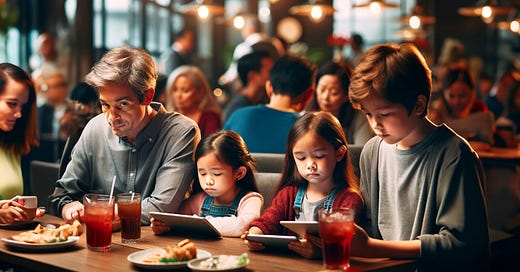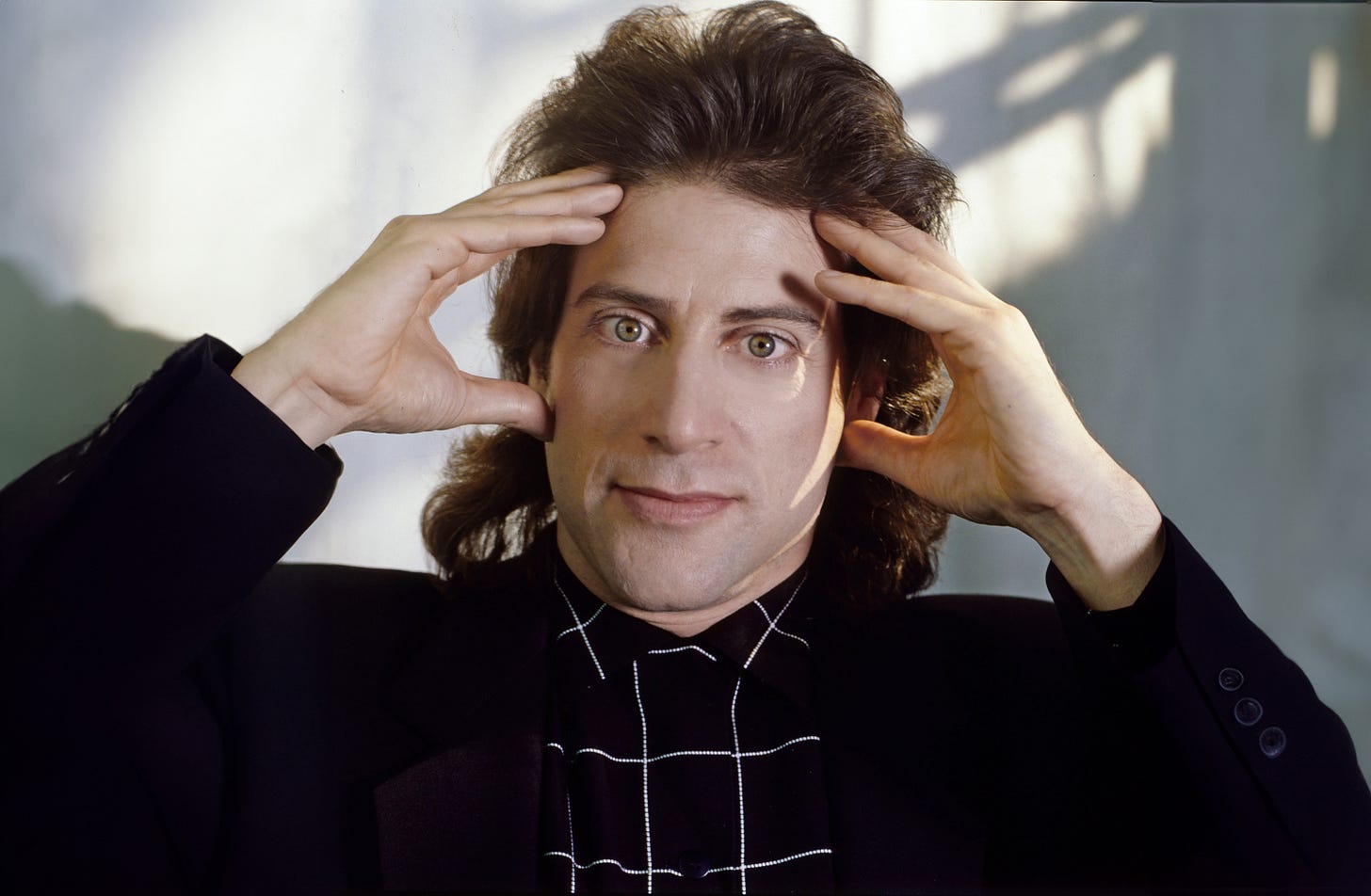Screens, Kids, and Pablo Picasso
Five short stories about kids engaging the world with screens and what I'm (finally) doing about it, as a parent.
1. A Restaurant (2017)
I'm annoyed.
I'm sitting in a restaurant with my family. The table next to us has two parents and two young kids. You know the scene. Both on iPads.
The volume was turned WAY UP on BOTH iPads. The tinny music of kids programming drifts over to our table. Ruins the conversation. I can't hear anything else. I'm fuming.
The parents -- each with a glass of wine in one hand and a phone in the other. Four people, four screens.
I don't say anything. But I make a mental note of the scene.
2. The Men’s Restroom (2018)
Back when I worked in an office every day, I noticed a trend in the men's restroom.
Sorry, ladies, but you have to know the truth. This happens EVERYWHERE now.
You see men standing at the urinal—ahem, one-handing it—while looking at their phones.
Swiping while peeing.
One-hand texting with the extreme thumb-reach — phone at shoulder-level — barely looking at the aiming (or not aiming) happening below.
It's not okay.
We all know people do this in the stalls. But standing out in the open? Gross. Can't that text chain wait the 45 seconds it takes to (as my grandma said) drain the radiator?
3. Another Restaurant (2023)
I took my three kids (13, 10, and 7) to Eataly for an early dinner. When it’s Dad’s night to cook, the kids get pasta.
Every other table—over 15 of them—had a mix of parents and young children. Every single child locked onto a phone or iPad while the parents talk. Each child, focused only on their own screen. No interaction.
One table had a teenager with giant white Beats headphones. That teenager never once engaged in the table conversation, and the parents ordered for him. When it was time to walk out, the family stood up, and almost gasped because the teenager was like 6-foot-3.
Because of event #1, we never allow screens at dinner, especially while dining out. So each of us has a book or drawing supplies.
The server takes our order and my kids struggle through ordering. Each has their own unique mix of impediments - embarrassment, volume, eye contact, indecisiveness - but they make it through.
And the server is shocked. She compliments the kids.
I'm shocked that she's shocked. (I’m not that shocked.)
4. Hair Salon (2024)
I needed a haircut, but my usual stylist wasn't available.
Joanne is a former hairdresser for movies and TV shows and was, apparently, the go-to person for Richard Lewis for about a decade (which is part of the reason my hair now has 22% more 90s comedian mullet vibes). She's wild and funny and a great hang. She laughs at my jokes for 30 minutes. She puts on a show, and I love going to her.
But she wasn't available so I took the first person available. It was a younger guy. Early-mid twenties. Stylish, tall, cool. Black guy with a Dodgers hat. Let's go.
I sit down and he asks me one question, never takes his AirPods out, and 30 minutes later, has uttered about four sentences to me.
It's like he wasn't in the room with me.
5. My House (Last Month)
As I re-read those four stories, I sound (to myself) VERY judge-y and VERY pompous. Trust me, I don't like that look.
So, lest you think that I THINK I'm a perfect person and/or parent, let me assure you, I am not. I've already shared my personal device demons in Duck Hunt and Dopamine. I'm a work in progress.
Here’s our household screen situation.
We have multiple family iPads (one for each kid), and they go on them every now and then, mostly on weekends, for a few hours each trip. We watch plenty of TV and movies and have a Nintendo Switch. We're not anti-tech luddites living in the forest. We do lots of screen time. Less than many, but not zero.
But six weeks ago, my wife and I—on a shared gut feeling—cut off the iPads for a weekend. When they pressed to explain why, we said, "We're taking a break, and we don't know how long. Let's just prioritize some other things."
This was a real problem for our eldest, who LOVES drawing on the iPad. She started during the Pandemic and has built a real artistic style. But even then, we cut it off and forced her to use other media.
One weekend turned into two, and now SIX. Two of those weeks included TWO weeks of Spring Break. Prime iPad time.
We allowed lots more TV time and Nintendo time - probably even too much.
And I'm here to report on the results of this impromptu detox: it's great.
We still get a daily five minutes of guff from one or all of the kids, but I'll gladly exchange five minutes of withstanding vitrol for 23 hours of joy.
These are radically different children. What’s different? The screens.
Here's the crazy thing -- not all screens are created equally.
While watching TV (cooking shows, kids shows, movies, Jeopardy), they engage. We joked about characters, story holes, ridiculous jokes, and connections to other interests. Same with video games. Those were gathering experiences in our living room. Those screens were ADDITIVE to our communal experience.
iPads? Not so much.
Those three kids would sit on the same couch, on three iPads, together but alone. And it always took HOURS for them to re-engage.
The lie of the last decade—for parents—is that YouTube Kids is "the same as TV.” Even if watched on a TV. It's not.
But YouTube Kids on an iPad is weaponized disengagement from the world around them.
Guernica
This one scene from the 2006 movie Children of Men stays with me.
In a world ravaged by worldwide infertility, there are no more births, and the human race is dying out. Panic ensues. One British politician saves the world's most meaningful art.
There is a dinner scene in the shadow of Pablo Picasso's famous war painting, Guernica. Two men are discussing the future of the human race.
They barely notice the 20-ish-year-old son, just a few feet away. He’s engrossed in his device. He is subhuman. His very presence is an annoyance. An afterthought. He is not there. He is useless, mindless, and disengaged from reality. Why would he engage when he is the last of his kind, destined to die alone? In this absurdist, fictional world, his only hope—his only cope—is the screen.
Considering the state of children today, it’s a hard watch.
Digital Wiring
We are training kids to favor digital experiences over human engagement.
I include myself in this judgment.
And we wonder why the first generation to experience screens as young children (Gen Z) is the loneliest ever.
They don't know how to engage with other people face-to-face.
And it's not just the kids.
It's me.
It's me when I get sucked into a disembodied state. It's me when I reach for my phone 150 times a day.
It's me when I yearn to complete some digital cycle, loop, or streak rather than sit in silence for 1.325 seconds.
It's bad for me, but as an adult, I have the ability to devise a plan to change. I'm doing that now.
I remember the before-times. Before screens.
My kids. Our kids. They don't. They have NO IDEA.
Their brains are being wired in.
Professor Jonathan Haidt is all over my social feeds — interviews, podcasts, and Twitter flare-ups — because of his new book The Anxious Generation.
I’ve ordered the book (Rainn told me to), but have read many reviews.
It comes down to this (my summary):
A “childhood of play” is spent navigating low-stress challenges in order to build up social connectedness and perseverance.
A “childhood of screens” (phones, tablets, social media) is spent navigating the self-centered ease of receiving all the information in the world, without important context, robbing children of basic skills needed to overcome challenges.
The result has been an unparalleled uptick in “mental illness” terms like anxiety, depression, and more.
How can the most advanced generation, with every advantage, be the most depressed.
Something’s not working.
Turning the Mirror(ed Glass) on Myself
So I took away the most addictive screens in the house.
And yet, this newfound discipline isn't only valuable for my kids.
It's for me.
I write this -- my first post in a month of distractions and rabbit-hole-dives -- possibly because I left my phone in the kitchen. It's not within reach.
You know when I have my most productive, mind-drifting, genius ideas?
Sitting quietly in church. Listening to a sermon. No phone. Surrounded by people. Thinking big thoughts. Thinking selfless thoughts.
So imagine my surprise when I read this article by Derek Thompson, host of one of my favorite podcasts, “Plain English,” and journalist for The Atlantic.
The self-described agnostic wrestles with “The True Cost of the Churchgoing Bust,” the negative effects of steady declines in religious affinity, identity, and church attendance across America over the past few decades.
One passage stood out:
And America didn’t simply lose its religion without finding a communal replacement. Just as America’s churches were depopulated, Americans developed a new relationship with a technology that, in many ways, is the diabolical opposite of a religious ritual: the smartphone. As the social psychologist Jonathan Haidt writes in his new book, The Anxious Generation, to stare into a piece of glass in our hands is to be removed from our bodies, to float placelessly in a content cosmos, to skim our attention from one piece of ephemera to the next. The internet is timeless in the best and worst of ways—an everything store with no opening or closing times. “In the virtual world, there is no daily, weekly, or annual calendar that structures when people can and cannot do things,” Haidt writes. In other words, digital life is disembodied, asynchronous, shallow, and solitary.
Religious rituals are the opposite in almost every respect. They put us in our body, Haidt writes, many of them requiring “some kind of movement that marks the activity as devotional.” Christians kneel, Muslims prostrate, and Jews daven. Religious ritual also fixes us in time, forcing us to set aside an hour or day for prayer, reflection, or separation from daily habit. (It’s no surprise that people describe a scheduled break from their digital devices as a “Sabbath.”) Finally, religious ritual often requires that we make contact with the sacred in the presence of other people, whether in a church, mosque, synagogue, or over a dinner-table prayer. In other words, the religious ritual is typically embodied, synchronous, deep, and collective.
That’s my big takeaway.
I’d like a life that embodied, synchronous, deep, and collective.
I’d like to spend less time disembodied, asynchronous, shallow, and solitary.
What’s good for my kids has to be good for me.
My phone needs a time out.
Thanks for reading. Would be delighted if you had a comment or something you’ve tried for yourself or your children in this area.
In five years, I’ll have THREE teenagers all at once. I NEED THE HELP.
Hey, it’s been a minute since I last wrote, so here are a few things I’ve been working on:
I’ve spent the last few months interviewing agency founders about their experiences selling their companies. We have so much in common. Both gratitude and deep hurts that don’t see the light of day. Thinking about starting a cohort or offering a bit of founder coaching. Interested in hearing more?
My brand consulting agency Spotlight & Co is launching a course for agencies to help them transform from production shops to strategic partners, through assessing the internal culture of their clients. Interested in hearing more?
My bathroom toilet overflowed, spilling a lake of poo-water into my living room. So our house is full of plastic sheeting and dividers like that makeshift science lab where they experimented on E.T.
I was interviewed twice. Once for
‘s podcast: Alec McNayr on The Tension Podcast and Tim Thompson interviewed me on McBeard’s acquisition for his RevThink community.
Have a great week, and if you’re not already subscribed:










I can’t talk enough about this. First loved the piece. I always imagine when I’m on my phone i have a huge brown bag over my head. Can’t see my kids, can’t really hear them, and I’m totally not present.
It seems crazy y we have to restrain ourselves from these things but it’s no joke, and life is SO MUCH BETTER when we get off the damn phone. I’m glad you wrote about this. Thank you
Thank you for this piece. I’ve so far been very pro device because I won’t lie, I use it as my baby sitter while I try to work full time from home/build a business and also look after the home all at the same time.
We got a Nintendo switch for the boys last Christmas and I’m seeing first hand how they interact with that vs how they are on their phones and the contrast now for me is stark. Especially with YT/YT kids where the programming just gets on my nerves.
My position has always been the world is awash with tech and I need to show them how to use it responsibly.
For me this has been bit of an eye opener and I liked how you positioned the change to your kids. I’d quite like to be off the phone myself, I’m starting to find it quite boring actually